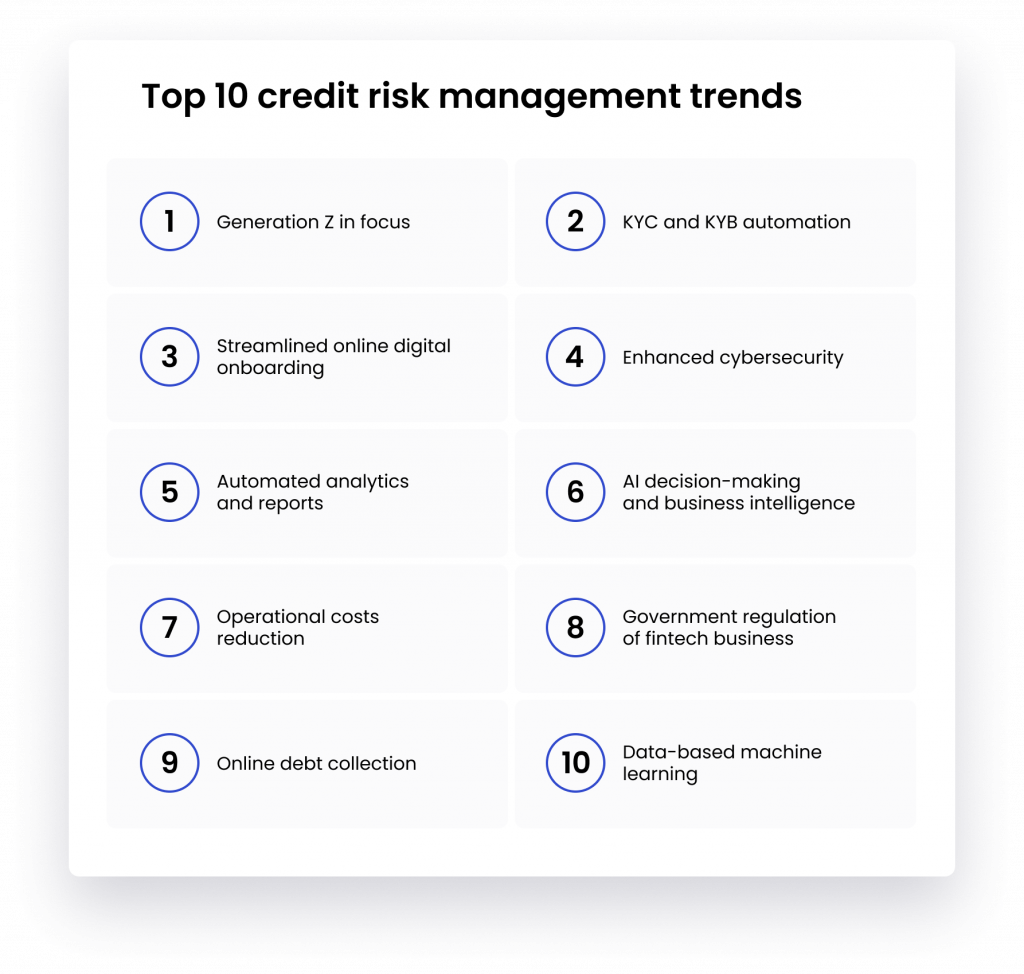
Digital transformation has long been discussed as a growing trend within the finance sector. Even despite the challenges it presents, it’s now a given that things are changing in a big way. Increased automation, faster turnaround times, and greater transparency, to name a few, are altering the way finance operates. One of the biggest changes, however, could be in how credit risk management functions.
What are the current challenges of credit risk management?
Credit risk management is the practice of the lender, a bank or other credit provider, to assess the risk of a borrower failing to make their repayments on their loans/debt. By evaluating the credit risk, the lending provider can make an informed decision about whether or not to issue a loan.
Traditionally, credit risk calculations took into account defined factors, such as past credit usage, payment history, its length, any applications made, and types of credit to analyze a person or a business’ creditworthiness. However, all that is changing.
As the Millennials (born between 1981 and 1996) and Gen Z (born between 1996 and 2009) start to show their financial power, their circumstances often do not align with past traditions. Factors, such as the gig economy, increased student debt, new approaches to debt and savings, technology usage, and general financial caution mean that they interact with finances in a whole new way, and existing credit models do not always accurately assess their creditworthiness. Although, of course, this is not the only factor in recent developments, it evokes a sense of urgency among lenders eager to cater to an emerging market. As credit risk management in fintech evolves, new credit risk management trends are coming to the forefront as a way to meet these challenges head-on. Below we’ll take a look at some of the biggest 2023 trends we expect to see in 2023 that will impact the industry for years to come.

Emerging trends in credit risk management 2023
No.1 Gen Z in focus
As we’ve said above, Gen Z’s entrance into the financial world is changing how things are done. Aside from having different needs to manage increased student debt, changes to working conditions, etc., they are a digital-first generation. This means they expect the services they use to be available to them when they need them, and to function as efficiently as possible.
According to the Bank of America, Gen Z is financially savvy. Despite challenges in saving due to external economic factors, over 73% are prepared to make changes (second jobs, changing employment, cutting back, etc.) to improve their financial situation. Additionally, this generation, along with millennials, are putting more trust in new fintech, leaving traditional financial companies if they fail to evolve in the dust.
Embrace the trend by:
- Catering to the emerging powers or Gen Z and Millennial markets
- Focusing on ease-of-use with a digital-first approach
No.2 KYC and KYB automation
Know your customer (KYC) and know your business (KYB), along with anti-money laundering (AML), are the cornerstones of financial regulation. That’s why it’s no surprise that this area needs an upgrade, especially considering financial institutions incurred $20 billion in fines in 2020 across data protection, KYC/KYB, and AML infractions.
Automating KYC and KYB processes in 2023 (and beyond) is set to top financial providers’ priority lists in the coming year. For example, such updates can include smart ID checking software, automated data extraction tools and more which make the process more streamlined for their clients.
Embrace the trend by:
- Upgrading your current KYC/KYB systems to more efficient ID verification tools
No.3 Streamlined digital onboarding
According to Deloitte, up to 38% of clients drop out of the onboarding process simply due to it taking too long and being too complicated. 2023 is the year this is all changing. Although digital banks have been successful at ensuring customers are satisfied with the digital experience, it’s time for the rest of the industry to take note.
Exploring omnichannel approaches that connect customers across the various platforms, ensuring the process is as streamlined as possible, and reducing the steps it takes to onboard and get a loan should be a top priority for lenders seeking to access the market. But doesn’t faster mean more risk? It doesn’t have to. Instead, credit risk management systems of the future should focus on making this process as smooth as possible using available technology, such as AI tools that allow clients to onboard and access the services they need swiftly without any additional risk to the business.
Embrace the trend by:
- Optimizing and upgrading onboarding processes and tools
- Exploring the latest credit risk management systems on the market
No.4 Enhanced cybersecurity
The need to maintain the ultimate security in the finance sector has led to a rise in investment in global security services revenue. Rising from $7.9 billion in 2019 to an expected $9.8 billion by 2024, the cybersecurity industry is laser-focused on protecting clients from fraud, unauthorized transactions, cybercrime, and other activities carried out to cause harm. 2023 is no exception, which is why, it’s no surprise that it continues as a trend when it comes to credit risk mitigation.
Companies in 2023 will be more focused than ever before on how to prevent cybercrime activities and ensure that systems are in place to reduce the credit risk, before the crime ever happens. For example, this may include flagging suspicious activity or accounts, ensuring compliance at new levels and more.
Embrace the trend by:
- Reviewing and upgrading your current cyber security practices and technology
No.5 Automated analytics and reports
Mistakes happen. It’s human. However, at the same time, this can be very costly for business, especially if it can be improved. In this coming year, there will be a focus on upgrading and automating reporting and analytics so that the data that influences decision-making is as accurate as possible.
This can be done by automating data entry, report generation and the use of handy dashboards that display the data required in the most meaningful way possible to ensure it is as accurate and clear as possible.
Embrace the trend by:
- Considering embracing automation software for data entry
No.6 AI decision-making tools and better business intelligence
When it comes to the biggest credit risk management trends of 2023, AI remains one of the most sought-after technologies. In recent years, upgrades in the sector have led to a number of advancements that allow businesses to function more efficiently. In the coming years, it’s likely that more and more companies outside the innovative fintech sphere will start to onboard Big Data analysis, interactive dashboards, and even AI decision-making tools, which can advise on the best outcome based on the available data, to boost their business outcomes.
When it comes to risk management, such tools, among other emerging tech, can help improve risk management and reduce risk stemming from fraud, and unauthorized transactions, among others.
Embrace the trend by:
- Seeking out the right tools to automate and analyze your available data
- Exploring how you can integrate AI decision-making into your business
No.7 Operational costs reduction
As they say, “time is money,” which is why optimizing and reducing operational costs this year is a priority. This comes in line with recent cutbacks in the tech sector and a focus on a more streamlined approach to businesses. However, those seeking to cut the costs also need to make sure they don’t jeopardize their business by creating unnecessary risks at the same time.
That’s why many are choosing to focus on optimization as a first priority. By concentrating on factors such as application processing time, streamlined onboarding, etc., financial businesses are able to deal with higher numbers of clients more quickly, increasing business productivity, and, in effect, profit. At the same time, this allows them to cut costs on manual labor and redirect employees to other areas of business.
Embrace the trend by:
- Creating a digital transformation strategy to optimize your business. Don’t just jump head-first on the trends, research and choose the approach that’s right for you.
No.8 Changes to government regulations
The 2022 year ended with the arrest of FTX founder Sam Bankman-Fried relating to the bankruptcy of his firm. This event marks a turning point and highlights the need for updated financial regulations, including those that cover the crypto industry. However, this is just one area in a wider system needing change.
Deloitte suggests that numerous factors are at play when it comes to how regulations will look in future. Alongside crypto security, climate change, a sustainable economy, the current structure of the market and more will impact government regulations in future. As such, companies seeking to minimize risk should start to analyze and prepare now for changes that while unconfirmed are coming in the near future.
Embrace the trend by:
- Analyzing the latest regulatory information and ensuring you have the technology in place to function effectively.
No.9 Online debt collection
Forget about knocking on doors. Forget about phone calls. Debt collection this year has got an upgrade. Prevention is the best cure when it comes to defaulting on loans. That’s why the best credit risk management should include software that helps clients to manage their risk effectively.
For example, this may include reaching out by sending reminders through apps of upcoming payments, being able to get in touch directly through less-threatening online channels, and evening helping clients assess ways to repay more effectively. Having the right tools at hand helps clients meet their credit obligations before the situation becomes critical.
However, if action does need to be taken, updated collection software can help your business analyze the appropriate amount to collect and set a workable schedule for this to happen, reducing the risk for both the client and your business.
Embrace the trend by:
- Getting the right tools on board to help your client manage their debt efficiently to avoid problems down the line.
No.10 Data-based machine learning
Machine learning (ML) isn’t just a buzzword of the moment. It has powerful implications that go beyond a one-year trend. The latest ML software draws upon historical data to help finance companies make predictions for the future. For example, smart credit scoring models utilize a diverse range of data to deliver more accurate credit scoring even faster, reducing risk while increasing customer satisfaction.
AI trained models build upon past results — successes and failures — to increase their accuracy rates as time goes on meaning that the credit risk mitigation system becomes more effective over time. Of course, this trend isn’t just limited to credit risk, such technology can also be engaged for wider organizational decision-making, among a whole host of other activities.
Embrace the trend by:
- Onboarding credit risk management software that will improve your risk calculation processes.
Embrace the credit risk management trends: next steps
The ability to efficiently manage credit risk is a critical factor in many businesses. As the financial market continues to evolve, including new types of clients, and evermore innovative fraudsters, companies operating the arena will need to seek out new ways to efficiently gauge the level of risk. The trends above are some of the most important this year that will continue into the future, but which one (or ones) will work for you will always depend on the specifics of your business and its particular needs.


